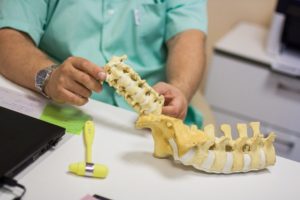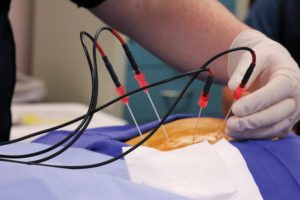There are many types of procedures that are minimally invasive and deal with back pain well. Rhizotomy is one of those procedures that many people from a non-medical background aren’t aware of. However, this procedure is one of the most effective minimally invasive methods that provides patients with an alternative to major surgical procedures to get relief from one of the most common issues faced by many – back pain.
In this piece, we will walk you through everything that you need to know about rhizotomy and what it involves.
WHAT IS A RHIZOTOMY?
Rhizotomy is a minimally invasive procedure that’s a treatment for acute back pain, or pain in the neck, or lower back pain originating from the spinal joints. This procedure is recommended as an alternative to traditional spine surgeries like fusion or laminectomy.
Simply put, rhizotomy involves stopping nerves responsible for carrying pain signals to the brain from operating and sending signals. In this procedure, the respective nerve roots are identified using various diagnostic and testing techniques, and then operated on.
There are two types of rhizotomy procedures which we will discuss in the next section. One of the two rhizotomy procedure types is also a minimally invasive method of treatment and as such is an outpatient operation. Patients usually do not need to get hospitalized for the minimally invasive rhizotomy. This procedure is recommended by doctors for long-term relief usually when you may have been suffering from chronic back pain, especially the lower back or the lumbar spine. People experiencing neck pain i.e the cervical spine pain and spinal joint pain are also candidates for this operation.
RHIZOTOMY PROCEDURES – RADIOFREQUENCY RHIZOTOMY & ENDOSCOPIC RHIZOTOMY
This procedure can be performed in two ways. The goal of these two methods is the same – to disable or disconnect the pain-causing nerves with the only difference being the method used.
In the radiofrequency ablation method, heat is used to disable the problem causing nerves. This procedure uses a needle that is used to transfer heat using radiofrequency waves that ablate or essentially “burn” the nerve endings of the targeted pain-causing nerves. How does the doctor pinpoint the location of the nerve causing the pain? To locate and pinpoint the nerve that needs to be operated on a fluoroscopic X-ray can be used. Once the problem-causing nerves are located, local anesthesia is applied to the patient’s back. A needle is then guided in using X-Ray. Generally, when people talk about rhizotomy, this is the only method they refer to. So, you may need to clarify which method is being talked about in that context.
The goal of this procedure is to make sure the patient receives long term relief from pain. This procedure can cause pain relief in patients for a period of 6 to 12 months, and is generally performed only once the operating surgeon has identified the facet joints using a medial branch block through a facet joint injection. If the MBB injections are effective in providing pain relief at the facet joint sites, the doctor will know radiofrequency can also be effective in longer term pain relief..
The endoscopic rhizotomy is another effective outpatient procedure. This procedure lets your surgeon directly visualize your nerve branches by making use of an HD endoscope. With a precise view of the nerves, the physician can ablate the pain-causing nerves accurately which provides the patient pretty significant and long term relief from neck and back pain. This minimally invasive procedure has the same fundamental similarities as radiofrequency ablation, with slightly different methodology.
The endoscopic rhizotomy is a viable option when dealing with pain in the back, as the surgeon can find the nerves causing pain and precisely target them. As such, once the procedure is done the patient gets immediate relief from pain as well as long-term relief. This procedure can be used to successfully treat patients suffering from various issues such as muscle spasms, long term back pain, leaning backward pain, patients who have had short term relief from the RFA method. This method has proven to be a great treatment for long term low back pain relief.
RHIZOTOMY PROS AND CONS
An endoscopic rhizotomy has the following advantages over the traditional radiofrequency rhizotomy:
- A doctor performing endoscopic rhizotomy can see the nerves directly and can precisely target the nerves that are causing the pain.
- Patients after an endoscopic rhizotomy can feel immediate pain relief whereas the effects of RFA can take up to a month to be felt.
- RFA can provide you relief for up to a year whereas endoscopic rhizotomy effects can last anywhere between 3 to 5 years.
As such an ER (Endoscopic Rhizotomy) procedure is performed if the RFA (Radiofrequency Ablation) procedure fails to provide long-term relief. The reason RFA is sometimes the better option is the lack of incisions and complications that go along with having a more invasive surgery. Radiofrequency ablation can provide pain relief long enough for other adjustments in lifestyle and physical therapy can help your body heal.
RHIZOTOMY RECOVERY TIME
Rhizotomy is minimally invasive, so the recovery time is relatively quick compared to other types of spinal surgeries. Usually patients can return to normal activities the same day as the surgery, but nothing too strenuous. You can shower, but soaking in a bath or hot tub isn’t advisable. Some patients experience some discomfort, bruising or soreness afterwards, which can be handled with an ice pack or over the count pain medication. Any discomfort should subside in a few days to a couple weeks, and maximum pain relief should happen at that point as well.

Side Effects and Complications of Rhizotomy
Rhizotomy is a fairly safe procedure so risks and complications are quite rare. If you experience any side effects such as these, contact your doctor:
- dizziness or weakness
- fever, chills, nausea, or vomiting
- redness, swelling, bleeding, or drainage at the injection site
- numbness that lasts for more than 2 or 3 hours
SHOULD I GET A RHIZOTOMY?
Medical science has made huge leaps in terms of treatments for any long term chronic health issues. If you have been someone who has been suffering from chronic neck and back pain for quite some time, you can talk to your doctor about whether or not rhizotomy is a potential solution. Thousands of patients have experienced long term pain relief utilizing rhizotomy.


